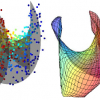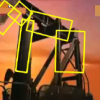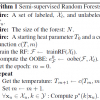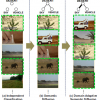ICCV
2009
IEEE
15 years 11 months ago
2009
IEEE
Supervised learning of a parts-based model can be for-
mulated as an optimization problem with a large (exponen-
tial in the number of parts) set of constraints. We show how
thi...
ICCV
2009
IEEE
15 years 11 months ago
2009
IEEE
We present a manifold learning approach to dimensionality
reduction that explicitly models the manifold as a mapping
from low to high dimensional space. The manifold is
represen...
ICCV
2009
IEEE
15 years 11 months ago
2009
IEEE
We present a method to learn visual attributes (eg.“red”,
“metal”, “spotted”) and object classes (eg. “car”,
“dress”, “umbrella”) together. We assume imag...
ICCV
2009
IEEE
15 years 11 months ago
2009
IEEE
We present a novel variant of the RANSAC algorithm
that is much more efficient, in particular when dealing with
problems with low inlier ratios. Our algorithm assumes
that there...
ICCV
2009
IEEE
15 years 11 months ago
2009
IEEE
Fusing partial estimates is a critical and common problem
in many computer vision tasks such as part-based detection
and tracking. It generally becomes complicated and
intractab...
ICCV
2009
IEEE
15 years 11 months ago
2009
IEEE
Face identification is the problem of determining
whether two face images depict the same person or not.
This is difficult due to variations in scale, pose, lighting,
background...
ICCV
2009
IEEE
15 years 11 months ago
2009
IEEE
In this paper, we introduce a novel iterative motion tracking
framework that combines 3D tracking techniques with
motion retrieval for stabilizing markerless human motion
captur...
ICCV
2009
IEEE
15 years 11 months ago
2009
IEEE
Random Forests (RFs) have become commonplace
in many computer vision applications. Their
popularity is mainly driven by their high computational
efficiency during both training ...
ICCV
2009
IEEE
15 years 11 months ago
2009
IEEE
We introduce a novel parametric BRDF model that can
accurately encode a wide variety of real-world isotropic
BRDFs with a small number of parameters. The key observation
we make...
ICCV
2009
IEEE
15 years 11 months ago
2009
IEEE
Learning to cope with domain change has been known
as a challenging problem in many real-world applications.
This paper proposes a novel and efficient approach, named
domain ada...





